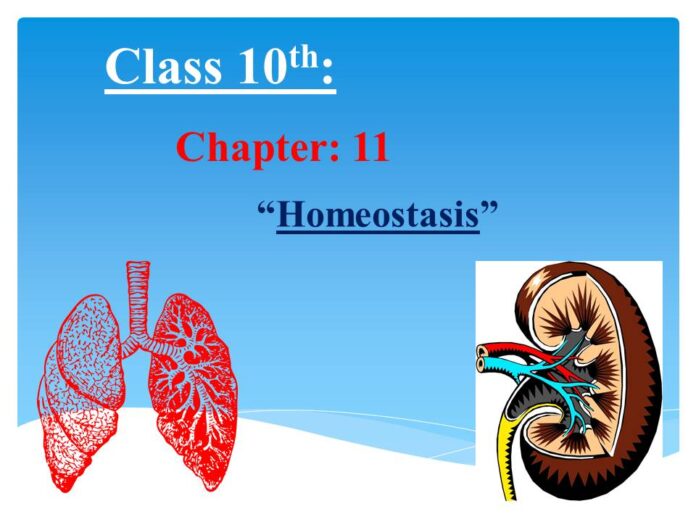
Biology 10th class MCQs for any test
Chapter: 11
“Homeostasis”
1. The maintenance of the internal conditions of the body at equilibrium, despite changes in the external environment is called
a) Osmoregulation
b) Homeostasis
c) Thermoregulation
d) Excretion
Sol: (b) Homeostasis
2. The maintenance of the amounts of water and salts in body fluids called
a) Thermoregulation
b) Osmoregulation
c) Excretion
d) Homeostasis
Sol: (b) Osmoregulation
3. The maintenance of internal body temperature is called
a) Thermoregulation
b) Excretion
c) Optimum temperature
d) All of these
Sol: (a) Thermoregulation
4. The loss of water from plant surface in the form of vapours is called
a) Transpiration
b) Vaporization
c) Sublimation
d) Condensation
Sol: (a) Transpiration
5. The appearance of water on the tips or edges of leaves is called
a) Dew
b) Guttation
c) Vaporization
d) Sublimation
Sol: (b) Guttation
6. Resins are removed by
a) Rubber tree
b) Keekar
c) Coniferous tree
d) Pines
Sol: (c) Coniferous tree
7. Calcium oxalate is deposited in the form of crystals in the leaves and stems of
a) Tomato
b) Pine
c) Rubber
d) Keekar
Sol: (a) Tomato
8. The plant which lives completely or partially submerged in freshwater are called
a) Xerophytes
b) Hydrophytes
c) Halophytes
d) All of these
Sol: (b) Hydrophytes
9. Mucilage is removed from
a) Ladyfinger
b) Carnivorous plant
c) Both (a) and (b)
d) Keekar plant
Sol: (c) Both (a) and (b)
10. Latex is extracted by a
a) Keekar
b) Rubber
c) Pines
d) Tomato
Sol: (b) Rubber
11. “water lily” is an example of
a) Hydrophytes
b) Xerophytes
c) Halophytes
d) None
Sol: (a) Hydrophytes
12. Xerophytes live in……….environment
a) Moist
b) Dry
c) Wet
d) All of these
Sol: (b) Dry
13. Rubber plant produces
a) Resins
b) Mucilage
c) Latex
d) Gums
Sol: (c) Latex
14. Succulent organs are present in
a) Xerophytes
b) Hydrophytes
c) Halophytes
d) None of the above
Sol: (a) Xerophytes
15. Cactus is an example of
a) Hydrophytes
b) Xerophytes
c) Halophytes
d) None of the above
Sol: (b) Xerophytes
16. The plants that live in sea waters and are adapted to salty environments are called
a) Halophytes
b) Xerophytes
c) Hydrophytes
d) None of the above
Sol: (a) Halophytes
17. Which organ in human remove carbon dioxide and keep it balanced
a) Skin
b) Lungs
c) Kidney
d) All of these
Sol: (b) Lungs
18. Which organ filters excess water, salts, and urea from the blood and forms urine
a) Brain
b) Stomach
c) Large intestine
d) Kidney
Sol: (d) Kidney
19. How many layers in our skin
a) Two
b) Three
c) Four
d) Five
Sol: (b) Three
20. Which layer has no blood vessels
a) Dermis
b) Epidermis
c) Hypodermis
d) None of the above
Sol; (b) Epidermis
21. Broad leaves are found in
a) Xerophytes
b) Hydrophytes
c) Halophytes
d) None
Sol: (b) Hydrophytes
22. Dermis layer consists of
a) Blood vessels
b) Oil glands
c) Hairs and fat cells
d) All of the above
Sol: (d) All of the above
23. Contraction of small muscles attached to hairs called
a) Goosebumps
b) Piloerection
c) Both (a) and (b)
d) Only (a)
Sol: (c) Both (a) and (b)
24. The excretory system consists of humans consisting of
a) Pair of kidneys
b) A pair of ureters
c) A urethra
d) All of these
Sol: (d) All of these
25. The bean-shaped organ called
a) Kidney
b) Lung
c) Stomach
d) Gall bladder
Sol: (a) Kidney
26. The weight of a kidney about
a) 125 grams
b) 120 grams
c) 121 grams
d) 119 grams
Sol: (b) 120 grams
27. The left kidney is a little ……….than the right
a) Higher
b) Smaller
c) Almost equal
d) None of the above
Sol: (a) Higher
28. The outer part of the kidney is called
a) Medulla
b) Renal cortex
c) Pyramids
d) Pelvis
Sol: (b) Renal cortex
29. Renal medulla consists of several cone-shaped areas called
a) Renal pyramids
b) Pelvis
c) Renal corpuscle
d) Renal tubule
Sol: (a) Renal Pyramid
30. The functional unit of the kidney is called
a) Cortex
b) Nephron
c) Loop of Henle
d) Collecting duct
Sol: (b) Nephron
31. How many nephrons in each kidney
a) Over 2 million
b) Over 1 million
c) Over 3 million
d) Over 4 million
Sol: (b) 1 million
32. Renal pyramids project into a funnel-shaped cavity called
a) Renal cortex
b) Renal tubule
c) Renal corpuscle
d) Renal pelvis
Sol: (d) Renal pelvis
33. How many parts of the nephron
a) One
b) Two
c) Three
d) Four
Sol: (b) Two
34. A network of capillaries called
a) Glomerulus
b) Bowman’s capsule
c) Loop of Henle
d) Renal tubule
Sol: (a) Glomerulus
35. Bowman’s capsule is
a) U-shaped
b) Cup-shaped
c) Bean shaped
d) Tale-shaped
Sol: (b) Cup-shaped
36. U-shaped portion of renal tubule called
a) Loop of Henle
b) Proximal convoluted tubule
c) Distal convoluted tubule
d) Collecting duct
Sol: (a) Loop of Henle
37. Which of the following are not filtered through the glomerular capillaries
a) Urea
b) Blood cells
c) Proteins
d) Both (b) and (c)
Sol: (d) Both (b) and (c)
38. The main function of the kidney is
a) Blood formation
b) Urine formation
c) Plasma formation
d) Bone marrow formation
Sol: (b) Urine formation
39. The typical volume of urine produced by an average adult is around
a) 1.1litre
b) 1.3litre
c) 1.4litre
d) 1.5litre
Sol: (c) 1.4litre
40. Amount of urea in the normal chemical composition of urine is
a) 9 g/l
b) 9.3 g/l
c) 8.3 g/l
d) 9.4 g/l
Sol: (b) 9.3 g/l
41. Potassium ions in the normal chemical composition of urine is
a) 0.650 g/l
b) 0.750 g/l
c) 0.450 g/l
d) None of the above
Sol: (b) 0.750 g/l
42. Hypotonic urine forms when the water in body fluids is
a) Less
b) In excess
c) Not filled
d) Absent
Sol: (b) In excess
43. Percentage of water in urine is
a) 90 %
b) 95%
c) 96%
d) 98%
Sol: (b) 95%
44. What percentage of kidney stones are passed through the urinary system by drinking plenty of water?
a) 90%
b) 80%
c) 70%
d) 75%
Sol: (a) 90%
45. What is the method used for the removal of kidney stones
a) X-rays
b) Kidney transplant
c) Dialysis
d) Lithotripsy
Sol: (d) Lithotripsy
46. What is the leading cause of kidney failure
a) Diabetes mellitus
b) Hypertension
c) Both (a) and (b)
d) None of the above
Sol: (c) Both (a) and (b)
47. Which type of dialysis can be performed at home
a) Peritoneal dialysis
b) Haemodialysis
c) In-center hemodialysis
d) None of the above
Sol: (a) peritoneal dialysis
48. Who wrote an encyclopedia “Al-Tasrif”
a) Bu Ali Sina
b) Darwin
c) Abu Nasr Al-Farabi
d) Abu-Al-Qasim Al-Zahrawi
Sol: (d) Abu-Al-Qasim Al-Zahrawi
49. In hemodialysis, a patient’s blood is pumped through an apparatus called
a) Blood pump
b) Dialyzer
c) Osteoporosis
d) None of the above
Sol: (b) Dialyzer
50. The average lifetime of a donated kidney is
a) Ten to twelve
b) Ten to thirteen
c) Ten to fourteen
d) Ten to fifteen
Sol: (d) Ten to fifteen
Important definition in chapter “Homeostasis”
1. Define homeostasis
2. Define osmoregulation
3. Define thermoregulation
4. Define excretion
5. Define metabolic waste
6. Define guttation
7. Define transpiration
8. Define halophytes
9. Define succulent organs
10. Define the term “Goosebumps”
11. Define nephron
12. Define glomerular filtrate
13. Define the loop of Henle
14. Define lithotripsy
15. Define hemodialysis
- Important Questions that are asked in the previous board:
1. What is the process to remove extra water in plants?
2. How oxygen is removed in plants?
3. Explain osmotic adjustments in plants?
4. Write the function of the kidney?
5. Explain the structure of the kidney with a diagram?
6. Write the function of the kidney?
7. What are kidney stones and how it removed?
8. What is kidney failure and explain its treatment method? - Why homeostasis is required?
- Related Search Article:
Class 9th MCQs:
Introduction to Biology
Solving a biological problem
Bio-diversity
Cells and Tissues
Stay connected with beingghazali.com for any biology test and wildlife blog.
(Fear is no policy, and surrender is no option)



Great knowledge
Very nice nice and great sir
Thank you sir for your feedback.